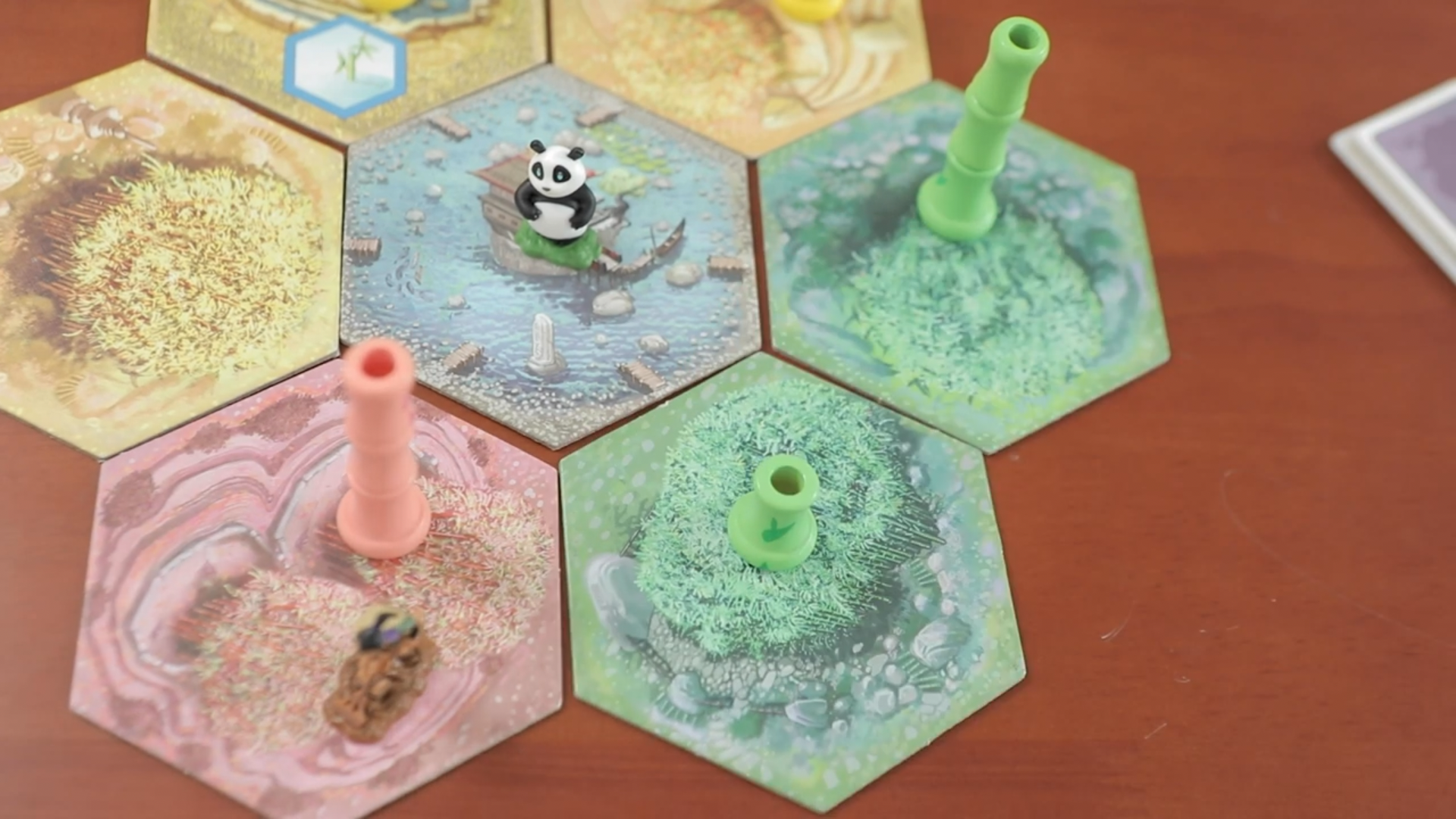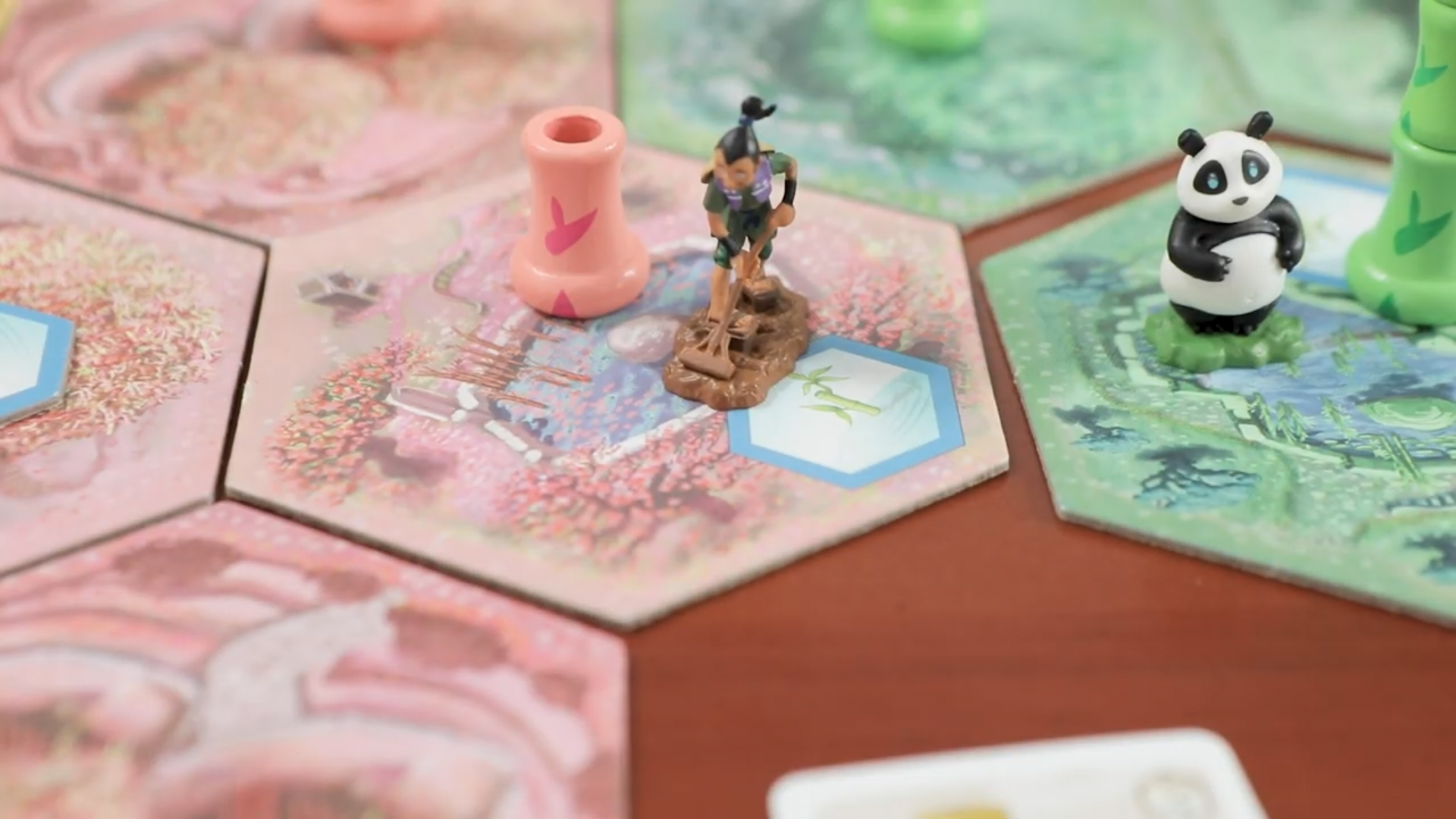Takenoko Review
Family friendly and competitively satisfying bamboo munching.
Manage a shared bamboo garden, achieving objective cards that ask for specific designs, or bamboo eaten. Plays from 2-4 players, in 30-45 minutes.
Video published March 23rd, 2020

Expand & irrigate the bamboo garden with 3 colors.

Roll for weather, then take 2 actions.

Be wary of the gardener and panda positioning!
Overview & How to Play
There’s a giant catch in setting up this beautiful bamboo garden—there’s a hungry panda running around!
Players will be trying to complete 3 different types of objectives: things that ask for the garden to be set up in a certain way, things that ask for bamboo to be grown a certain way, or the last one asks for you to have the Panda eat a certain amount of bamboo. When a player achieves a certain amount of these, they get 2 more points and trigger the final round.
As for the turn by turn, players just choose 2 of the following actions:
1. Draw 3 plot tiles, then pick one to place in the garden.
2. Grab an Irrigation piece to later help water the garden. Bamboo will only grown on irrigated plots of land.
3. Move the Gardener, and he grows bamboo where he lands, and adjacent plots of the same color.
4. Move the Panda, and he eats one bamboo where he lands.
5. Draw another objective card.
Also, during any time on your turn, you can score an objective.
Pros
Takenoko just looks so bright and friendly. There’s pre-painted miniatures for the Panda and Gardener, luscious plot tiles, and 3D bamboo that you can stack!
This gardening game is all about growth, with a fantastic progression as players slowly grow upon the central pond. More plots will allow for more opportunities for objectives in hand, which need to be tightly managed, since one can never exceed 5 in the hand, and can never discard any. You gotta fulfill an objective to remove it from your hand.
With the constantly growing garden, and multiple objectives to fulfill to grab more, players also need to look out for sneak attacks, that is players suddenly achieving a bunch of their objectives in one turn, to trigger the game end. So how many points does each player really have?
These 3 objective decks are only 15 cards each too, leading to lots of room for your skill improvement as you slowly memorize what is possible. The more you play, the more you can start to predict what cards someone else has, and this gives you insight on what bamboo to eat to counter them, or even on what objective deck to draw from, if you think they haven’t drawn a certain card yet. Takenoko will really start to click after a handful of games, where you’ll begin to understand why people are pulling the garden in certain directions.
Turns maintain interest through plenty of counterplay and random weather affecting growing. Players can improve the land to deny others’ objectives, like preventing the Panda from ever eating on a space, or fertilize to improve growing on their wanted hexes.
Takenoko just ends up being a fantastic example of gameplay meeting theme when looking at everything holistically. Everything has to be irrigated to grow, bamboo grows faster than the panda can eat it, and even weather will play a factor in garden growth.
Nitpicks
The only nitpick we have is that the bamboo pieces: while looking excellent, they can physically sometimes get in the way of smooth gameplay. They’re set up in a way that only the upper parts of each shoot connect in a certain way, so sometimes one can spend a little too much time mid-game trying to find the right connections. Also, they’re not exactly the most tightly fitting for how thing they are, causing some occasional collapses on the board as they stack up to 4 plastic pegs high.
Final Thoughts
Takenoko is in this weird spot in the board game ecosystem though. It is frequently dismissed as both a family game, and a game that is worth taking a competitive look at. This problem comes up where there is a steep incongruence with how Takenoko presents itself versus how it actually is. It is labeled as a family game due to the cute theme and high accessibility, but game openings can be left uncomfortably vague without a deeper understanding of the objective decks.
On the flip side, more serious gamers can get quite irritated on luck when they don’t fully understand the objective decks, as point scoring can appear random. When one starts placing tiles without any heed of what others are going for, the counterplay magic is gone.
But hey, Takenoko is over 10 years old, and still holds up gameplay wise today! Just make sure you go into this with the right expectations of objective deck counterplay.













